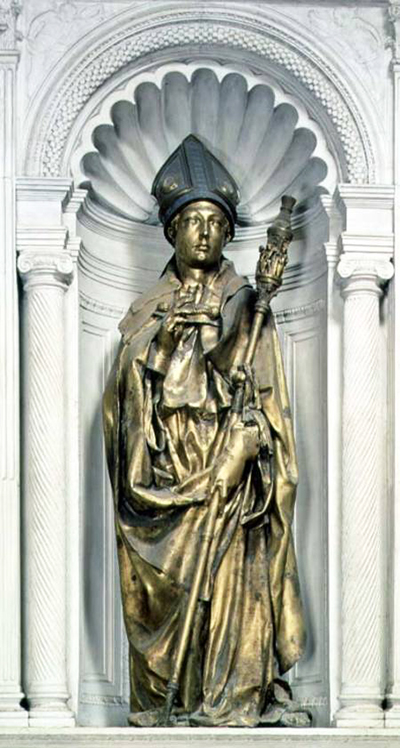Saint Louis of Toulouse is a bronze sculpture created by Donatello which currently resides in Museo di Santa Croce in Florence.
The sculpture, built between 1423 to 1425 has a shimmering feel to it due to the various techniques Donatello used in its creation process. The choice of material used is the first most important thing that determined its unique character which was an alloy metal of bronze.
The lost waxing technique used in alignment with the alloy made it possible for Donatello to bring out the shimmering effect together with some markings, intentionally left to reflect the light at certain angles.
Donatello also used a piecing technique to put Saint Louis together since it was a large sculpture. The pieces which were eight, of separate parts and accessories like a sceptre and an archbishop's hat were then put together using fire gliding procedure to hold them in place while giving the shiny gold like appearance. In addition to the precious metals used, a beautification process was applied like the use of jewels, rock crystal and an enamel coating to give Saint Louis a glossy impression.
According to some scholars and curators, its believed that Saint Louis was gilded together. The gilding process which involves covering the sculpture with a thin gold paint or gold leaf makes a convincing argument due to the size of the Louis. An amalgam technique was also used in the process by combining gold and mercury to complete the Louis making it different from other works of Donatello like the David sculpture.
Materials and Theme used
Saint Louis' life story gives the sculpture it's theme and reasoning behind the various materials used in its creation. Louis who was the eldest son of the ruler of Naples and Sicily at the time, Charles the second rejected his birthright to the throne and instead decided to follow a spiritual path.
The story made Louis be considered a Saint due to the various actions he partook in his lifetime and a sculpture was to be built in remembrance to his actions. The religious theme was to be upheld as it would depict the sainthood Louis had and housed in the church at Orsanmichele in Florence creating a niche of the Guelph party.
Humility and servitude themes are other depictions of the Saint Louis sculpture showing his tucked sandals under the hem. The mission work he had committed to the church, specifically the pope whom he had been obedient to, was portrayed in the tucked sandal. Other priesthood attributes were the mitre he wears representing the chosen profession and commitment to his course and religion. In addition, the cloak and Crosier he carries confirms the priesthood theme which also confirms his rank since the bishop's staff symbolizes high ranking in the Catholic church.
The short-lived life of Saint Louis who was born on February 9, 1274, and died on August 19, 1297, is another depicted theme having lived only 23 years. Donatello illustrates Saint Louis having boyish features with a feel of naïve expression on his face with his right hand giving a blessing while the left holding a crosier.
A religious statement was another theme which was put across as opposed to the political incorrectness going on at the time. Donatello and the church achieved this by using a classical marble and gold niche to bring out the ‘glorious’ appearance strategically positioning it near the sun's rays.
Dramatization and provocation of human nature was another theme used by Donatello in the Saint Louis sculpture bringing out his personality to light. The use of emotions on the figurine while bringing out the humility, naïve and boyish look on Saint Louis face and posture confirms his humanity like the rest of us yet contrasts with the covered glory of the priesthood.
Another example of similar depiction is the detailed intricate and naturalistic folding on Saint Louis tunic which is from Renaissance period and style. The style borrowed by Donatello is based on the Greek and Roman artwork which dived deep into human emotions and nature. This can be seen when Saint Louis uses the gesture of blessing to connect with the audience and express himself giving the sculpture a personality.
Artists related to the work of Donatello
Lorenzo Ghiberti who was a sculptor was the first to train Donatello in the art process of metalsmithery acting as an apprentice in his workshop. At a young age, he had learned stone carving at a cathedral in Florence about 1400 before apprenticing for Lorenzo between 1404 and 1407. The basic foundation of the sculptor in bronze and carving helped kick-start his journey in the field.
Nicolas Matas is another great artist who contributed to the works of Donatello during the Guelph faction when the sculpture became politically incorrect and had to be moved to Franciscan Santa Croce. The move which happened around 1459 while Donatello was alive saw the stature losing its significance from the mid-15th century to the 1860's when Nicola created a new façade for the statue.
Bruno Bearzi, who is an art connoisseur is another big contributor to the art of Donatello during and after the second world war. Bruno who was an art lover went all the way to Florence and tried shielding the sculpture from possible destruction suggesting it should be taken back to its original location, the Orsanmichele.
Ludovica Nicolai who is an enthusiast of Donatello's work is undoubtedly one of the biggest contributors to his work. After Saint Louis sculpture suffered slight damage during a flood in 1966, Ludovica who is a restorer has tried to recondition the statue. Since Ludovica is experienced with most of Donatello's work including restoration of the bronze David housed at the Bargello museum, he qualified for its reinstatement process.




